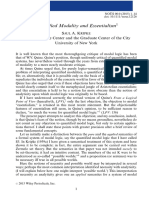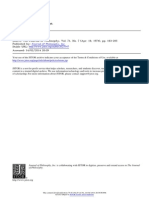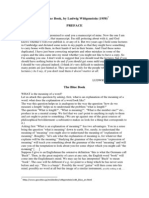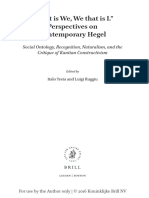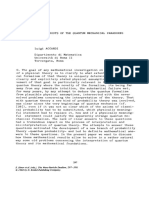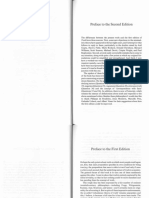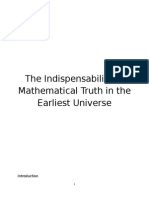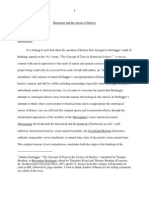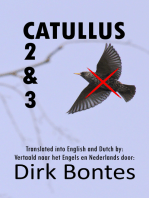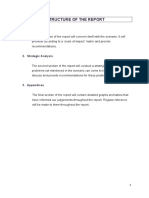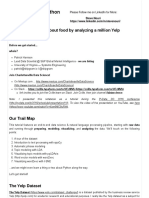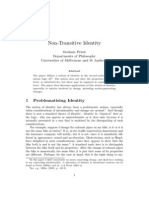Quine On Logic
Quine On Logic
Uploaded by
Fred_MayweatherCopyright:
Available Formats
Quine On Logic
Quine On Logic
Uploaded by
Fred_MayweatherOriginal Title
Copyright
Available Formats
Share this document
Did you find this document useful?
Is this content inappropriate?
Copyright:
Available Formats
Quine On Logic
Quine On Logic
Uploaded by
Fred_MayweatherCopyright:
Available Formats
AGORA - Papeles de Filoscfia=- (2001), 20/1: 139-156
ISSN 0211-6642
QUINE ON LOGICAL TRUTH AND CONSEQUENCE
Jose M. Saguillo University of Santiago de Compostela
Introduction
Quine is perhaps the most important American philosopher ofthe XX century and his impact is easily felt in almost every branch of analytic philosophy. He has provided original viewpoints, careful analyses and perhaps solutions to some of the perennial problems of philosophy. You may disagree with Quine but you have to recognize his influence in order to get a good understanding of the present state of the issue, whatever that may be. His recent demise has prompted new publications in his honor, providing with new analysis and assessments of his main contributions. This paper focuses on Quine's philosophy oflogic. Specifically, I want to discuss his distinctive conception of logical truth and logical consequence. The perennial question I selected for this occasion, which Quine addresses in several publications, can be formulated as follows: what is the necessary and sufficient condition for a sentence to be logically true? Similarly, what is the necessary and sufficient condition for a sentence to be logically implied by a set of sentences?
Summary
According to Quine, logic is first-order. For him, the underlying logic of all rational thought is a standard first-order logic without identity, without indivicl ual constants and without function constants, a logic which is two-valued, tenseless, extensional, non-modal, non-intuitionistic and one-sorted, a logic which is (in a sense) a proper sublogic of virtually every logic used as an underlying logic in the literature of classical mathematics and science, a logic which merits being called conservative. His conception of the logical properties gives priority to logical truth. Roughly, Quine holds that in order for a sentence to be logically true it is necessary and sufficient for it to be true and to remain true under any uniform lexical substitution of its content-terms. Derivatively, in order for a sentence q) to be logically implied by a set of sentences I" it is necessary and sufficient for there to be no single uniform lexical substitution of content-terms that makes every member of I" true and <1> false. Since, intuitively speaking, the relation of a sentence to its lexical substitutions is a matter of grammar, logical truth and logical implication are thus a matter, as Quine emphasizes, of grammar and truth. My purpose is to discuss Quine's distinctive view oflogical truth
139
Aceptricion: Diciembre 2001
Jose M. Sagiiillo
Quine on logical truth and consequence
and logical implication and to analyze the main features and philosophical import of his conception. This paper has five sections. The first fixes the terminology and stresses the fact that Quine takes logical truth to be prior to logical implication. Section two identifies three core features of the Quinean conception; hisfixed-uniuerse, fixed-content, non-modal conception is discussed in the light of Tarski's distinctive contribution to these perennial issues. Section three analyses the grounds for Quine's view and his claim that his account is co-extensional with the current model-theoretic conception. Two necessary conditions for this alleged adequacy are considered: (a) the first-order language must contain elementary arithmetic, (b) identity must be nonlogical. In section four the role that Quine's "parsimonious" ontology plays in his conception is briefly discussed in historical perspective. Section five concludes with a brief historical survey of the main achievements ofBolzano, Russell, Tarski and Quine on logical truth and consequence.
Key-words: logical truth; logical consequence; argument; argument-text; validity; substitution; interpretation; model; ontology; philosophy of logic.
1. Preliminaries
In his earlier works, Quine used the word 'statement' for the primary bearers of truth-values; he would say that every statement is a declarative sentence. Quine's use of the word 'statement' is comparable to what we would understand as a sentence or string of characters arranged according to grammatical rules, together with a suitable interpretation in a given fixed universe.
Statements are sentences, but not all sentences are statements. Statements cornprise just those sentences which are true and those which are false. These two properties of statements, truth and falsity, are called truth values [ ... J. The sentences 'What times is it?', 'Shut the door', 'Oh, that I were young again!', etc., being neither true nor false, are not counted as statements. Only declarative sentences are statements. But closer examination reveals that by no means all declarative sentences are statements.
(Quine 1941/65: 5)
Quine then goes on to specify that declarative sentences containing indexicals, such as, 'I am ill', or 'It is drafty here', are neither true nor false. According to Quine, indexicals are ambiguous words and they have to be properly revised in order to make their meaning explicit before we can accept a declarative sentence in which they occur, as a statement.
In his later works, Quine gave up his use of the word 'statement' due to the -then- increasing usage at Oxford of this word for the individual events of utterance. Quine explains that in order to avoid a potential ambiguity he adopted the word 'sentence' to mean "interpreted sentence", in abstraction from the individual events or verbal performances of their utterances. Discussing sentences in this last sense involves -according to Quine- a suitable simplification for the purposes oflogical studies, for he contends that
140 AGORA (2001), Vol. 20, n° 1: 139-156
Jose M. Sagiiillo
Quine on logical truth and consequence
-strictly speaking- it is concrete speech acts that are true or false. See Quine (1940/94: 11), Quine (1950/82: 4), Quine (1970186: 2 and 13-14).
At this point I would like to suggest the existence of a sort of gap in Quine's views, between his logical theory and his basic philosophy. This feature is exemplified in more than one pair of related concepts, one of which is the formal counterpart in his idealized logical model of the corresponding preformal one in his basic philosophy. The first concept replaces the second in saying not what the second is but rather what the second is like. For the present concern, Quine in his basic philosophy considers events of utterance as the bearers of truth and falsity whereas in his idealized model he derivatively takes sentences to be true or false': Even more derivatively, he speaks sometimes of eternal sentences. An eternal sentence is a sentence whose tokens all have the same truth-value. Paradigmatic cases of these are the sentences of arithmetic. Quine also indicates that eternal sentences have that status relatively to the given language in use, whether a formal language of arithmetic or some portion of ordinary English.
In referring to Quine's discussion I shall predicate truth and falsehood of sentences in the previous sense. Likewise, Quine discusses implication as a relation that holds between sentences or between a [finite] set of sentences and a single sentence. I shall use the expression 'argument-text' to refer to a two-part system composed of a [finite or infinite] set of sentences P (the premise-set) and a single sentence c (the conclusion). An argument-text with premise-set P and conclusion c is valid if and only ifP implies c; i.e., if and only if c is a logically implied by P. Thus, in the discourse of this paper, validity is predicated of [interpreted] argument-texts>.
It is also useful at this starting point not to overlook the fact that Quine takes logical truth to be prior to logical implication. In any finite universe of sentences, logical implication can be defined on the basis oflogical truth, and conversely. The choice adopted been of no technical or philosophical significance: P logically implies c if and only if the conditional whose antecedent is the conjunction of the sentences in P and whose consequent is c, is logically true. However, the issue has import when considering infinite universes of sentences (perhaps not even closed under conjunctions and conditionals). Clearly, not every first-order argument-text admits of a suitable
1 Perhaps the important issue of meaning in Quine's conception suggests another example of the same sort of gap or tension: formal semantics virtually evaporates in his logic as opposed to his elaborated behaviorist conception of meaning in his basic philosophy. But this is not my present concern.
2 Quine explicitly rejects that it is propositions expressed by sentences in a given interpretation that are true or false and that it is arguments composed of propositions expressed by argument-texts that are valid or invalid.
141 AGORA (2001), Vol. 20, n" 1: 139·156
Jose M. Saguillo
Quine on logical truth and consequence
one-sentence translation in a standard language. Specifically, no argumenttext with an infinite premise-set allows such a single sentence translation".
2. The fixed-universe, fixed-content, non-modal viewpoint of logical truth
In several places (Quine 1936, 1940/94 and 1954/63), Quine defines logical truth by means of three preliminary notions:
i) Vacuous occurrence of an expression: an expression occurs vacuously in a given statement if its replacement in each of its occurrences by any and every other grammatically suitable expression leaves the truth or falsehood of the statement unchanged.
ii) Vacuous variants of a statement: for any statement containing some expressions vacuously, there is a class of statements, describable as vacuous variants of the given statement. These statements have the same skeleton and truth-value, but being diverse in exhibiting all admissible variations upon the vacuous constituents of the given statement.
iii) Essential occurrence of an expression: an expression occurs essentially in a statement ifit occurs in all the vacuous variants of the statement, i.c., if it forms part of the aforementioned skeleton.
Using these notions, Quine gives his definition oflogical truth relative to a previously specified class oflogical constants in a given interpreted first-order language":
3 Take the universe of natural numbers and consider a language L, whose only logical constants are the conjunction '&', the conditional '-/, the universal quantifier 'v' and whose nonlogical constants are the numeral '0' for zero, the successor functor's' for the successor function and one monadic predicate 'P' interpreted on that universe. The infinitely many numerals in this language are '0', 'sO', 'ssO', and so forth. Consider the argument-text whose conclusion is the universal sentence ''ilx (Px & 'ilyPyl' and whose premise-set consists in all of the instances 'Po & 'ilyPy', 'PsO & vyl-y', 'PssO & '1yPy' and so forth, formed by substituting each of the numerals for 'x' and dropping the quantifier. Of course, there is no single sentence translation of this valid argument-text.
4 This is not exactly what Quine does in his 1970/86 book, but it suffices for the present expository purposes. In this latter book, pp. 50-51, Quine endorses what he takes to be the simplest one-step version of his intended definition: "A logical truth [ ... J is definable as a sentence from which we get only truths when we substitute sentences for its simple sentences". He also adds that sometimes this (my emphasis) definition is given by resorting to the notion of valid logical schema. A schema results from a sentence by substituting its predicates by schematic letters. A logical schema is valid if every sentence obtainable from it by substituting sentences for simple sentence schemata is true. Finally, he defines a logical truth, as a truth obtainable from valid logical schema. Next, in the same paragraph he writes, "This two-step definition oflogical truth amounts to the same thing as the one step one [ ... J" (my emphasis). Despite of its alleged potential usefulness in terms of generality, in a sense, this second two-step definition looks redundant, perhaps even circular, since a valid logical schema can only be obtained from a given logical true sentence in the first place.
142 AGORA (2001), Vol. 20, n" 1: 139-156
Jose M. Sagiiillo
Quine on logical truth and consequence
The logical truths, then, are those true sentences which involve only logical words essentially. What this means is that any other words, though they may also occur in a logical truth (as witness 'Brutus', 'kill', and 'Caesar' in 'Brutus killed or did not killed Caesar'), can be varied at will without engendering falsity'.
(Quine 1954: 357)
The footnote corresponding to the footnote-mark in the previous quotation indicates that Quine was aware at that time, that his definition did not work, "unless the phrase 'can be varied at will' is understood to provide for varying the words not only singly but also two or more at a time". In effect, the sentence 'Two is oblong= or four is even' will remain true for any substitution of only one of the two disjuncts, and hence, without provision for varying its two expressions at a time, it will be rendered logically true. 'Two is oblong or four is even' can be turned into a falsehood only by simultaneous substitution of both disjuncts. Although Quine says that this point was made to him in private communication by Myhill, who acknowledges Benson Mates in turn, it also appeared in print in the 1968 detailed article "Logical truth revisited" by Hinman, Kim and Stich",
Quine's substitutional account involves three fundamental features that should not be overlooked:
1. Fixed-universe: the purported definition only considers the universe of the given interpretation of the language. In this sense, his conception can be called local. No other universe, neither an expansion nor a restriction of the one that is given in the intended interpretation is contemplated. Regarded from our current model-theoretic conception this peculiarity of Quine's definition may look unsatisfactory, since logically true sentences are independent of the particular universe that the language happens to be interpreted in. In a word, this feature jeopardizes the topic neutrality oflogical truth and logical implication.
2. Fixed-content: The interpretation of the language is kept fixed. N () changes in the extensions attached to the non-logical terms are allowed in the present characterization. Quine thinks that logical truth is relative to a given language. In his syntactic or intra-linguistic view, changing the language changes the concept oflogical truth involved. In this sense, his concept is immanent rather than transcendent (See Quine 1970/86: 19-29). Thus, according to Quine, given two languages, we have two concepts of logical truth having in common that each of their interpretations are kept fixed. Perhaps this seems ahistorical to say the least. Tarski in his seminal 1936 paper on consequence cogently
5 In order for a natural number to be oblong it is necessary and sufficient for it to be the product of two consecutive numbers.
6 I am also indebted here to .Iosep Macia for illuminating comments reflecting on Quine's purported definition.
143 AGORA (2001), Vol. 20, n° 1:139-156
Jose M. Saguillo
Quine on logical truth and consequence
argued that his semantic or extra-linguistic conception was superior to the syntactic or intra-linguistic conception. In effect, it is at least conceptually possible for there to be a sentence in a given language that does not have a countervariant, or an argument-text that does not have a counterargument-text due to the limited means of expression in that language. Hence, we may contrast the Tarskian no countermodels viewpoint of validity -involving semantic devices such as, sequences, satisfaction and model- with the Quinean no expressible countermodels viewpoint -involving lexical substitutions-, the first being superior to the second in the level of generality obtained. See Corcoran (1983: xixii),
3. Non-modal: Quine's substitutional account oflogical truth holds that if a given sentence is logically true, then every sentence having the same [grammatical] structure as the given sentence is true, and conversely. This amounts to no countervariant expressible in the language. Mutatis mutandis, validity of a first-order argument-text means that every argument-text having the same [grammatical] structure is truth preserving, or materially valid, and conversely. This amounts to no counterargument-text expressible in the language. Briefly stated, truth and consequence are non-modal, or rather de-modalized in Quine's conception. His characterization is made purely in terms of generality in accordance with his well-known avoidance of modal notions. Thus, Quine's conception can be qualified as reductionist in the sense that logical truth amounts to truth in the given interpretation under every suitable substitution for the fixed-content terms ofthe language.
Quine's fixed-universe, fixed-content, non-modal characterization of logical truth and logical implication deserves a more detailed commentary.
In the first place, Quine is aware of the above mentioned locality feature when he writes
An incidental difference is the variability of U; the old definition lin terms of substitution] supposed a fully interpreted object language with no option left open as to the range of variables.
(Quine 1970/86: 52)
Here lies a potential shortcoming of the Quinean account already indicated in Hinman et al. (1968), Boolos (1975) and Shapiro (2000). If regarded from the standpoint of our current model-theory, the fixed-universe conception inflates or over-generates the class of logical truths. Specifically, if no variation of the universe of the interpretation is allowed, every pure cardinality sentence is logically true if true of the universe of the given interpretation of the language, and it is logically false if false ofthe universe of the given interpretation. For example, consider the first-order language of
144 AGORA (2001), Vol. 20, n° 1: 139-156
Jos« M. Sagiullo
Quine on logical truth and consequence
arithmetic interpreted on the universe of natural numbers. The sentence (A) 'There are at least two numbers' is logically true, and the sentence (B) 'There are at most two numbers' is logically false.
In effect, their canonical translations are:
(A) 3x 3y -, (x = y)
(B) 3x 3y Vz (x = z v y = z)
Notice that each of these sentences only contains expressions occurring essentially. However, according to the non-fixed universe viewpoint of contemporary model-theory neither is (A) logically true since it is false in a universe with just one object, nor is (B) logically false since it is true in a universe of at most two objects. From a historical perspective, it is illustrative to indicate that this very same criticism has also been raised to the Tarskian first viewpoint of validity. In effect, Tarski's approach in the thirties is developed within the framework of Principia Mathematica, in which the possibility of a larger or a smaller universe of discourse is not considered. This first view contrasts with Tarski's later set-theoretical non-fixed universe conception developed during the fifties, where changes in the universe of discourse are contemplated. Thus, Tarski's latest global, or topic neutral account gained a higher level of generality over his previous local account by avoiding dependency on the size ofthe universe of the given interpretation.
In the second place, by having an immanent or intra-linguistic conception of logical truth and consequence, Quine's approach fails to take into account the possibility of a larger or a smaller language. In other words, the language under consideration may not have "enough" expressions in it to provide for the required countervariants or counterargument-texts. For example, take the first-order language of arithmetic with addition as its only primitive and no definitions, and consider the argument-text in this language whose only premise and conclusion are respectively, the associative law and the commutative law of addition. In this context Quine's substitutional account renders the argument-text valid. This shortcoming is explicitly shown when expanding the given language with, for example, the string-theoretic concatenation functor over the universe of two-digit numerals, which of course is associative but not commutative.
Tarski had anticipated and discussed this unfortunate possibility. In order to deal with it in the above example he would have had the symbol for addition replaced by a suitable function variable. Under Tarski's fixed-universe variable-content conception, validity of the above argument-text would have required that every function that satisfies the associativity condition, also satisfies the commutativity condition, which of course is not the case. Briefly stated, Quine's fixed-universe, fixed-content account seems to provide with a necessary but not a sufficient condition for a sentence to be logically true or for an argument-text to be valid.
145 AGORA (2001), Vol. 20, n° 1: 139-156
Jose M, Sagiiillo
Quine on logical truth and consequence
In the third place, Quine's characterization de-modalizes logical truth and consequence. The necessity conception, the impossibility conception and the information containment conception are perhaps the most invoked modal descriptions of our pre-formal understanding of logical properties. However, no modal feature is incorporated into Quine's definitions. Carnap in his autobiography has suggested Tarski and Quine both agree on the reduction of these modal notions to some or another non-modal ones of generality. It is tempting to think that Quine would regard modal notions as mere vestiges of a psychological attitude. Although there are different levels of generality as it was already indicated, generality prima facie is something we seem to understand better than modality. However the philosopher misses from Quine's account the explication of the intuition that logical truth is a species of necessary truth or that a logical truth lacks information. The open question is what is special or specific about the generality involved in the modal component of logical truth and consequence. A subsidiary question (but not less important) is in what sense if any, a [extensional] mathematical logic actually incorporates our previous modal intuitions. There are some interesting suggestions in that direction in Garcia-Carpintero (1993) and Shapiro (1998). One way or another, these two articles suggest that our model-theoretic semantics represents or captures some important features related to our pre-formal modal notions oflogical truth and consequence. For views granting the modal feature of our preformal conceptions but not detecting it in the Tarskian semantics see G6mez-Torrente (1996) and Saguillo (1997).
3. The grounds for the Quinean conception
It has been emphasized so far that the concept of logical truth and consequence developed by Quine differs from that of our current modeltheoretic semantics. In short, Quine's definition makes logically true sentences dependent both, on the universe chosen, from which the extralogical terms are interpreted, as well as on the extra-logical means of expression available in the language. It is tempting to explore whether -always within Quine's framework of first-order logic- the present substitutional account can come to terms with the model-theoretic account. Indeed, in his 1970/86 book, Quine claims that both accounts are coextensive as long as two conditions are satisfied:
1. The first-order language considered must contain enough means of expression for elementary arithmetic.
2. The identity sign must belong to the non-logical vocabulary.
146 AGORA (2001), Vol. 20, n" 1: 139-156
Jose M. Sagiiillo
Quine on logical truth and consequence
The first condition implies that the universe of the interpretation of the language is infinite. In this connection, Shapiro (2000: 339) points out that if the universe of the intended interpretation had been finite, the sentence,
[vxyz (Rxy & Ryz --+ Rxz) & 'v'x3y RxyJ --+ 3x Rxx
would have been logically true in the Quinean sense with 'R'interpreted as the less-than relation, whereas in the model-theoretic sense it is false in the universe of natural numbers.
More importantly, the strength required for the language is also related to the -often invoked by Quine- fundamental results of Lowenheim (L) and of Hilbert-Bernays (H-B) for first-order logic. The L-theorem establishes that any set of first-order sentences that comes out true under a given interpretation it also has a true interpretation in the domain of the natural numbers. On the other hand, Quine qualifies the H-B theorem as an improvement on the L-theorem. It shows that for any given consistent set of sentences, its true interpretation in the universe of natural numbers can be expressed in the language of arithmetic. Both theorems, Quine maintains, allow us to bypass interpretations and talk directly oflexical substitution:
However extravagantly the classes may outrun the expressions, this theorem [L-H-BJ assures us that when we define validity and consistency it is indifferent whether we talk of all and some interpretations in the sense of classes or in the sense of terms. The theorem assures us that all those extra classes will be indifferent to validity and consistency in this sense: if a schema is fulfilled (or falsified) by some unspecifiable interpretation involving nameless classes, it is also fulfilled (or falsified) by some other interpretation that can be written in the notation of arithmetic.
(Quine 1950/82: 212)
To see that every sentence in a first-order language of arithmetic is logically true in the substitutional sense if and only ifit is logically true in the model-theoretic sense we can proceed as follows. The conditional from left to right can be established by contraposition. Suppose that a given sentence <t> of the language is not a logical truth in the model-theoretic sense. Then <t> has a countermodeL By the L-theorem <t> has a countermodel in the universe of natural numbers. By the H-B theorem, the arithmetic predicates involved in this interpretation can be defined in the language. Hence, every non-logically true sentence has a countervariant obtained by suitable substitution of its content-terms by arithmetical ones. The conditional from right to left follows from the [weak] completeness of first-order logic. Any sentence that is logically true in the model-theoretic sense is deducible by means of some standard calculus, which by virtue of its soundness only generates true sentences under all substitutions?
7 See (Quine 1970186: 53-55). G. Boolos (1975: 52-53) claims to have a counterexample for the alleged adequacy of Quine's definition. Apparently, Boolos shows that there is a satisfiable set of sentences in a sufficiently rich language (in accordance with Quine's requirement) that cannot be turned into a set of truths by uniform substitutions in the given language.
147 AGORA (2001), Vol. 20, n" 1: 139-156
Jose M. Scgiiillo
Quine on logical truth and consequence
So far we merely have a prima facie "postulation" of the adequacy of Quine's account. Another necessary condition for its alleged co-extensionality with the model-theoretic conception is the non-logical treatment of identity, witnessed the case of pure cardinality sentences, as indicated in section two above. In his Philosophy of Logic (1970/86), Quine clearly takes identity to be defined in terms of the non-logical terminology of the language. It is fair however, to indicate that there is a sort of ambivalence in his different works regarding the nature of identity. Undoubtedly, in many of them, Quine takes the sign of identity to be logical. For samples" see (Quine 1946: 70), (Quine 1947: 43), (Quine 1950/82: 4) and (Quine 1991: 244).
According to Quine, identity means -in agreement with his immanent conception- indistinguishability within the language. In other words, two things "are" one in case they are not discernible within the limits of expression of the language under consideration. What he does is to smuggle a simulated identity or an equivalence relation by taking as the bases of the definition of identity the [necessarily] finite class of predicates available in the language. Often, Quine uses the following, or a similar "toy" example for the purpose of illustration". Take a language with three primitive predicates, two monadic 'P' and 'Q' and one dyadic 'R'. Quine's identity ofx and y can then be defined as
\/x\/y [x = Y H (Px H Py) & (Qx H Qy) & \/z [(Rxz H Ryz) & (lRzx H Rzy)] 1 This method by exhaustion of combination of the primitive predicates makes the user of the language to manage something that behaves like identity but that could actually fail to do its intended job when considering two objects not distinguishable within the expressive power of the language. Hodges (1983: 78) stresses the import of Quine's maneuver with the remark that "It also has the consequence, not mentioned by Quine, that for any two different things there is some language in which they are the same thing." By contrast, it is worth noticing that real identity is not first-order definable.
8 The relevant passages in those works are the following:
"All true statements which (like '(x) (x = x)') contain only logical signs are naturally to be classified as logically true". (Quine 1947: 43).
"Their characteristic [of logical truths] is that they not only are true but stay true even when we make substitutions upon their component words and phrases as we please, provided merely that the so-called "logical" words '=', 'or', 'not', 'if-then', 'everything', 'something', e tc., stay undisturbed". (Quine 1950/82: 4)
"The logical signs are the truth-function signs, the quantifiers, the variables of quantification, and the identity sign". (Quine 1991: 244).
"l. .. ] my constructions differ essentially from theirs in presupposing no auxiliary logical machinery beyond the elementary level: truth functions, quantification, and identity". Quine (1946: 70).
This ambivalence about the status of identity can turn into confusion when reading contemporary surveys of Quine's logical theory in which identity is said to be logical, together with connectives and quantifiers. See for example, A. Orenstein's entry dedicated to Quine included in the Routledge Encyclopedia of Philosophy.
148 AGORA (2001), Vol. 20, n" 1: 13.9-156
Jose M. Sagiiillo
Quine on logical truth and consequence
In this connection, Quine indicates an "exchange" of logical truths that is thereby obtained, bringing to better terms his inclination to consider identity as part of logic". It so happens that taking the equations of his simulated identity as abbreviations of sentences constructed by exhaustion in the fashion indicated above makes all laws of identity become mere abbreviations of logical truths (in his sense) of pure quantificational theory. (See Quine 1970/86: 64). Simulated identity hence, obtains an analogous or proxy logical status induced by the defining sentences.
A final comment should be added to make his concept of logical truth perhaps plausible, in the case of valid argument-texts with infinite premises. Since these cannot be rewritten as a single sentence, we may be facing another source of inadequacy for the Quinean substitutional account, in this case, by way of restricting or undergenerating the appropriate class of valid argument-texts. The Quinean viewpoint, somehow, "manages" to cover up its stance with a surrogate, due to the compactness theorem of first-order logic. Consider a valid first-order argument-text with an infinite premise-set. Adding the negation of the conclusion to the infinite premise-set gives an inconsistent [infinite] set. By compactness, this inconsistency can be "traced back" so to speak to a finite subset. Hence the validity of the given argumenttext, "lies" within a finite fragment of the given argument-text. In other words, due to compactness, all valid first-order argument-texts having an infinite premise-set are redundant, in fact infinitely redundant.". It goes without saying it that the so "contained" non-redundant finite argument-text has a corresponding conditional transcription, which of course, is logically true. However reducing an invalid argument-text with infinite premises in a similar manner becomes less sensible. To show that an infinite premise-set does not imply the given conclusion requires showing that all the infinitely many corresponding conditionals have countervariants.
4. The role of Quine's ontology in his conception of logic
Quine never steps beyond the tangible or concrete unless it is unavoidable.
He borrowed the expression particularism from N. Goodman to name the nominalist view -held by him at some point of his intellectual life- that rejects propositions and properties and countenances just physical objects
9 See for example Quine (1995: 52) and Quine (1970/86: 63).
10 This inclination is based on a delicate balance, where among other conditions, maximal generality as well as the completeness of the first order identity theory is highlighted.
11 in order for an argument to be redundant it is necessary and sufficient for its conclusion to be implied by a proper subset of its premise-set. Likewise, an argument is infinitely redundant if and only if it has an infinite premise-set and its conclusion is implied by a finite subset of its premise-set.
149 AGORA (2001), Vol. 20, »: 1: 139-156
Jose M. Sagiullo
Quine on logical truth and con8equence
and [mental] sensory events. Later on, his ontology "borrowed furniture" from the Platonic realm since -as Quine emphasizes- "even a soft science requires classes". In addition, his strict sense of economy allows for no kind of redundancy, whether waste or (perhaps) even useful, as long as it is theoretically dispensable. This parsimonious sense of ontology is invoked in favor of his substitutional account over the standard model-theoretic account. Logic, should presuppose no ontology, or at least its ontology should be as modest as possible, the motto says. In this vein, ifthe context allows it, Quine would even welcome avoiding sets.
The evident philosophical advantage of resting with this substitutional definition, and not broaching model theory, is that we save on ontology. Sentences suffice, sentences even of the object language, instead of a universe of sets specifiable and unspccifiable
(Quine 1950/82: 55)
A related sustained thesis is that second-order logic does not belong to logic but it is rather 'set theory in disguise', or even more conspicuously, 'set theory in sheep'S clothing'. Logic, Quine contends, should be ontology free and second-order logic has a "staggering" ontology. From a historical perspective, it should be noted that the idea of reducing logic to the exclusive limits of truth functions and quantification seems to have had very little history before Quine became a mature thinker. In other words, his radical first-orderism may look ahistorical, and yet, conservative. For example, Corcoran (1980: 192) reports that one of the pre-God eli an aims of mathematical logic was the characterization up to isomorphism of mathematical structures witnessed in the work of Huntington and Veblen among others. He points out that by the time of Skolem 1920, "it was clear that no uncountable systems (e.g., geometry, the reals, or the complex numbers) could be categorically characterized in first order, and there appears to have been very little interest in first order languages before that". Mendelson (1997: 381-382) also endorses the view that second-order and higher-order "were the implicitly understood logics of mathematics until the 1920s". In a similar vein see also Church (1956: 329-332). More to the point, Corcoran (1987) indicates that "in modern times higher-order logics were studied before first-order logic was isolated as a system worthy of study in its own right". On this score, Mendelson credits Lowenheim (1915), Hilbert in his 1917 unpublished lectures, and Hilbert & Ackermann's book, whose first German edition dates back to 1928, for the distinction between first-order and second-order languages. The point is that Quine does not contemplate classes under the scope of logic, adopting a viewpoint contrary to the main trends of modern logic -including logicism and the mathematical and the algebraic schools- dating from the second half of the nineteenth century and on into the 1920's.
In an extensive study of the controversy between first-order and secondorder logic, Shapiro (1991) suggests that Skolem and Godel anticipated first-
150 AGORA (2001), Vol. 20, n" 1: 139-156
Jose M. Sagiiillo
Quine on logical truth and consequence
orderism, although perhaps in each case, this foretaste was prompted by different motivations. However, he suggests that the first-order turn was never fully justified but merely urged:
As far as I can determine, neither Skolem nor Godel gave detailed reasons for their insistence on first-order logic. In both cases, the assertions were not merely directives that first-order logic is the most interesting or fruitful area for research; they were claims that higher-order variables do not belong in logic.
Shapiro (199]: 181)
Be that as it may, Shapiro (1991: 193) claims that the Skolem-Godel proposal crystallized as a genuine Kuhnian paradigm: "[. .. J the vast majority of textbooks in logic written after 1940 hardly mention higher-order terminology". Maybe a more detailed assessment of this affair is forthcoming from the sociology of science quarter, framing perhaps, Quine's advocacy of first-order languages within the rising in those years of a new trend or research program in logic.
Likewise the Quinean conception is nested in his overall epistemology.
According to him, the entire conceptual framework of science is postulated in order to facilitate making predictions based on past experience. Thus, not only, let us say, physics or psychology, but also mathematics and logic get involved in this utilitarian postulation. In other words, the scientific web stands or falls by the success or failure of its predictions, but these predictions are implied jointly by the lcgico-mathernatical as well as the nonmathematical sentences in its fabric. At face value, this web metaphor makes logic appear to be at least indirectly supported by experience. In addition to that, it poses a difficulty to reconciling his emphasis in tracing a neat boundary between logic and mathematics, on the one hand, with the overall cooperative model for producing successful predictions on the other. The question arising is why should a sharp border between logic and mathematics be imposed if the web of beliefs works holistically with no sharp border between logic-mathematics and natural science?
On the other hand, taking the pragmatics of science seriously makes even harder to understand Quine's conception of logic so severely constrained. His first-orderism provides at most, a simplified or idealized picture in neat disagreement. wit.h mathematical practice in light of the well-known fact that many other fundamental concepts of mathematics -in addition to the already mentioned identity- are not first-order definable, such as mathematical induction, well-ordering, ancestral, etc. It should not go unnoticed, by contrast, that Tarski's celebrated 1936 definition of logical consequence is generally thought to reflect previously accepted practice developed by working mathematicians. Of course, Tarski's definitions in the thirties are correspondingly framed within a higher-order system.
151 AGORA (2001), Vol. 20, n" 1: 139-156
Jose M. Saguillo
Quine on logical truth and consequence
5. Concluding remarks
The model-theoretic conception of logical truth and consequence that is most widely accepted today, and which goes back at least as far as Tar-ski (1953) diverges substantially from the substitutional conception favored by Quine. Moreover, it also diverges from the account of logical properties provided by Bolzano, Russell and Tarski's first view in the thirties. To start with the agreements, it should be emphasized at the outset that all these logicians (including Tarski in the thirties but not in the fifties) worked in a logical framework of an interpreted language, having a fixed-universe of discourse. Having said this, Quine is the only first-orderist among them. Implicitly or explicitly, Bolzano, Russell and Tarski worked within a higherorder framework. On this score, it is worth noticing that Bolzano took propositions as the bearers of truth and falsity and his discussion of logical properties involved a non-defined operation of substitution of concepts or ideas within propositions. In a word, his account abstracts from peculiarities of concrete languages>. On the contrary, it is weU known that Quine would not endorse a discourse committed to propositions like Bolzano's.
Russel1 (1903/37 and 1919193) considered the formal implication viewpoint of validity. Russell's general idea consists in transforming a given argumenttext into a generalized object-language material conditional. In other words, he considers the universal closure of a truth-functional conditional obtained by appropriately substituting variables for content-terms, whose antecedent is the conjunction of the premises and whose consequent is the conclusion of the given argument-text. The given argument-text is formally valid if and only if the corresponding universalized conditional is materially, or truthfunctionally true. Certainly, Quine would not approved of a similar characterization of his conception, but it is tempting to think of his definition as even with Russell's in avoiding argument-texts with infinitely many premises but uneven in taking a first-order language instead of a Ianguage of types as the object-language. It should be added pace Quine that in this rough description, which for the most part I take to be accurate of his own account, the second order universal quantifier ranges over the available content-terms in the object language, and hence is substitutional, not objectual.
Tarski's original approach also considers sentences in the sense of this paper and discussed logical consequence between sets of sentences and a single sentence in the framework of Principia Mathematica. The enlargement ofthe generalization obtained by means of his semantic devices is far superior to any ofthe preceding definitions. In addition, Tarski also takes into account the fact that in many scientific contexts, logical consequence relates infinite premise-sets with individual sentences. Likewise, Tarski deserves the credit
12 For details on the Bolzanian account see Corcoran and Galanti (1985) and Simons (1992), chapter two.
152 AGORA (2001), Vol. 20, n° 1: 139·156
Jose M. Saguillo
Quine on logical truth and consequence
for being the first who clearly indicated what terms to vary in order to characterize the "proper" concept oflogical truth and consequence, namely, all the non-logical terms. In this sense, he superseded Bolzano, who discussed different logical properties and relations with respect to different classes of varying ideas. Finally, It should also be emphasized that Tarski is the only one of these logicians who has provided with an account of the logical notions; namely, his well-known criterion of invariance under permutations of the universe onto itself". On this score, Quine follows what most logicians do, namely, just presenting the logical terminology of a given language by providing a list.
Perhaps, Quine's greatness lies precisely in having forced the burden ofthe proof upon his opponents -those fonder of promiscuous ontologies- in the search of a more philosophically loaded conception of logical phenomena. Indeed, a logician of a different orientation could claim that one notorious feature of Quine's philosophy oflogic resides in what it does not say or explain. Indeed, his sharp views about neat boundaries upon logical issues invites us all to a constant self-critical examination of our own standards of objectivity. But for the same reasons, I take his challenges to elicit consideration -under the same self-critical constraints- of the other non-Quinean side of logical matters.
Acknowledgments
Through the years I have benefited from discussion with John Corcoran on logic and specifically, on Quine's philosophy of logic. A first draft of this paper resulted from a presentation made at the Coloquio Compostelano de L6gica y Filosofia Analitica held in Santiago de Compostela in May 2001. I am grateful to Concha Martinez, Jose L. Falguera, Uxia Rivas and Juan Vazquez for their comments. A second version of it was presented at the Buffalo Logic Colloquium held in September 2001. Special thanks to John Corcoran, Sriram Nambiar, Barry Smith, Peter Hare and John Kearns for their questions and suggestions. A final version of it was presented at the Congress Formal Theories and Empirical Theories held in Santiago de Compostela. On that occasion I could incorporate improvements from Enric Casaban (Valencia), Stewart Shapiro (St. Andrews), Felipe Gago (Santiago de Compostela), Josep Macia (Barcelona) y Pedro 'Obeda (Valencia). I thank them all for useful correspondence and personal exchanges on issues related to my presentation. This paper is supported by research projects PB98-0631 of the Secretarta de Estado de Politica Cientffica y Tecnologica of the Ministerio de Ciencia y
13 See Tarski's posthumous 1986 article.
153 AGORA (2001), Vol. 20, n" 1: 139-156
Jose M. Saguillo
Quine on. logical truth and consequence
Tecnologta and PGIDTOOPX120502PN of the Secretaria Xeral de Investigaci6n e Desenvolvemento of the Xunta de Galicia.
References
BENACERRAF, P. and PUTNAM, H. (eds.) (1964/89): Philosophy of Mathematics. Cambridge, New York, Port Chester, Melbourne and Sydney:
Cambridge University Press.
BOGHOSSIAN, P. and PEACOCKE, C. (eds.) (2000): New Essays on the A Priori. Oxford: Clarendon Press.
BOOLOS, G. (1975): On second-order logic. The Journal of Philosophy LXXII, 509-527. Reprinted in Boolos 1998, 37-53.
BOOLOS, G. (1998): Logic, logic and logic. Edited by R. .Ieffrey with introduction and afterword by J. Burgess. Cambridge, Massachusetts and London: Harvard University Press.
CARNAP, R. (1937171): The logical syntax of language. 8th ed. London:
Routledge and Kegan Paul.
CARNAP, R. (1947/60): Meaning and necessity. 3rd ed. Chicago: The University of Chicago Press.
CHURCH, A. (1956196): Introduction to mathematical logic. lOth ed.
Princeton, New Jersey: Princeton University Press
CORCORAN, J. (1972): Review of Quine 1970. Philosophy ofScience :39, 97- 99.
CORCORAN, J. (1979): Review of Quine 1970, sixth printing. Mathematical
Reviews 57, 1237-8.
CORCORAN,J. (1983): Editor's introduction to Tarski 1983, xv-xxvii. CORCORAN, J. (1995): Information recovery problems. Theoria 24, 55-78. CORCORAN, J. (1996): Semantic omega properties and mathematical
induction. The Bulletin of Symbolic Logic 2, 468.
CORCORAN, J. (1998): Information-theoretic logic. In Martinez, Rivas, and Villegas-Forero 1998, 113-135.
CORCORAN, J. (1999): Information-theoretic logic and transformationtheoretic logic. Included in Ram 1999, 25-35.
CORCORAN, J. and GALANTI, E. (1985): Review of George 1983.
Mathematical Reviews 85i:03010.
GABBAY, D. and GUENTHNER, F. (1983): Handboo]; ofPhilosophical Logic.
Volume 1. Dordrecht: Reidel Publishing Company.
GARCIA-CARPINTERO, M. (1993): 'The grounds for the model-theoretic account of the logical properties'. Notre Dame Journal of Formal Logic 34, 107-131.
GEORGE, R. (1983): 'Bolzano's consequence, relevance, and enthymemes'.
Journal of Philosophical Logic 12,299-318.
154 AGORA (2001), Vol . .20, n" 1: 139-156
Jose M. Sagiiillo
Quine on logical truth and consequence
GOMEZ-TORRENTE, M. (1996): 'Tarski on logical consequence'. Notre Dame Journal o/Formal Logic 37, 125-151.
HAHN, L. E.. & SCHILPP, P. A. (eds.) (1986/98): The Philosophy 0/ W. V Quine. 2nd ed. The Library of Living Philosophers, XVIII. Chicago and La Salle, Illinois: Open Court.
HINMAN, P., KIM, J. and STICH, S. (1968): 'Logical truth revisited'. The Journal ofPhilosopliy LXV, 495-500.
HODGES, IN. (1983): 'Elementary Predicate Logic'. Included in Gabbay, D. and Guenthner, F. 1983, 1-131.
MARTINEZ, C., RIVAS, U. and VILLEGAS-FORERO (eds.) (1998): Truth in perspective. Aldashgate, England and Brookfield, Vermont: Ashgate Publishing Company.
MENDELSON, E. (1964/97): Introduction to mathematical logic. 4th ed.
London and New York: Chapman and Hall.
QUINE, W. v. (1936): 'Truth by convention'. In Benacerraf and Putnam 1989, 329-354.
QUINE, W. V. (1940/94): Mathematical logic. Revised edition. Cambridge, Massachusetts and London: Harvard University Press.
QUINE, W. V. (1941/65): Elementary Logic. (Revised edition). New York:
Harper Torchbooks.
QUINE, W. v. (1947): 'The problem of interpreting modal logic'. Journal o] Symbolic Logic 12,43-48.
QUINE, W. v. (1950/82): Methods ofLogic, Cambridge, Massachusetts:
Harvard University Press.
QUINE, W. v. (1953/80): 'On what there is'. From a logical point of view. 2nd edition. Cambridge, Massachusetts and London: Harvard University Press.
QUINE, W v. (1953/80): From a Logical Point of View. Cambridge, Massachusetts and London: Harvard University Press.
QUINE, W V (1954): 'Carnap and logical truth' included in Benacerraf, P and Putnam, H. 1989, 355-376.
QUINE, W. v. (1960/89): Word & Object. Cambridge, Massachusetts: The M.LT. Press.
QUINE, W. v. (1969): Ontological relativity and other essays. New York:
Columbia University Press.
QUINE, W. v. (1970/86): Philosophy of logic. Second edition. Cambridge, Massachusetts and London: Harvard University Press.
QUINE, W. V. (1981): Theories and things. Cambridge, Massachusetts and London: Harvard University Press.
QUINE, W. V. (1987): Quiddities. Cambridge, Massachusetts: Harvard University Press.
QUINE, IN. V. (1990/92): Pursuit of Truth. Cambridge, Massachusetts and London: Harvard University Press.
155 AGORA (2001), Vol. 20, n" 1: 739·156
Jose M. Sagiullo
Quine on logical truth and consequence
QUINE, W. v. (1991): 'Immanence and validity'. Reprinted in Quine 1966/95, 242-50.
QUINE, W. v. (1966/95): Selected logic papers. Cambridge, Massachusetts and London: Harvard University Press.
QUINE, W. v. (1995): From Stimulus to Science. Cambridge, Massachusetts and London: Harvard University Press.
RAM, M. (Ed.) (1999): Fragments of Science: Proceedings of The Mendel Sachs Symposium. Singapore, New Jersey, London, Hong Kong: World Scientific.
SAGUILLO, J. M. (1997): 'Logical consequence revisited'. The Bulletin of Symbolic Logic 3, 216-241.
SCHIRN, M. (1998): The Philosophy of Mathematics Today. Oxford:
Clarendon Press.
SHAPIRO, S. (1991): Foundations without foundationalism: a case for secondorder logic. Oxford: Clarendon Press.
SHAPIRO, S. (1998): 'Logical consequence: models and modality'. In Schirn, M. (1998).
SHAPIRO, S. (2000): 'The status of logic'. In Boghossian, P. and Peacocke, C. 2000, 333-366.
SIMONS, P. (1992): Philosophy and Logic in Central Europe from Bolzano to Tarshi. The Netherlands: Kluwer Academic Publisher.
TARSKI, A. (1933): 'The concept of truth in formalized languages'. In Tarski 1983, 152-278.
TARSKI, A. (1936): 'On the concept of logical consequence'. In Tarski 1983, 409-20.
TARSKI, A. (1941194): Introduction to logic. 4th edition by J. Tarski. Oxford:
Oxford University Press.
TARSKI, A. (1983): Logic, Semantics, Metamathematics. 2nd edition, (introduced and edited by J. Corcoran). Indianapolis: Hackett Publishing Company.
TARSKI, A. (1986): 'What are logical notions?' (introduced and edited by J.
Corcoran). History and Philosophy of Logic 17, 143-154.
TARSKI, A., MOSTOWSKI, A. and ROBINSON, R. (1953): Undecidable Theories. Amsterdam: North Holland Publishing Company.
156 AGORA (2001), Vol. 20, n" 1: 139-156
You might also like
- Gioia 2020 A Systematic Methodology For Doing Qualitative ResearchDocument10 pagesGioia 2020 A Systematic Methodology For Doing Qualitative ResearchJack WaltonNo ratings yet
- Semantical Considerations On Modal LogicDocument6 pagesSemantical Considerations On Modal Logicpierresg100% (1)
- AA SL IA Sample 1Document19 pagesAA SL IA Sample 1abcd1234No ratings yet
- Against "Ostrich" Nominalism 1980Document10 pagesAgainst "Ostrich" Nominalism 1980Fábbio CerezoliNo ratings yet
- Rogers Albritton, On A Form of Skeptical Argument From PossibilityDocument24 pagesRogers Albritton, On A Form of Skeptical Argument From PossibilityapplicativeNo ratings yet
- Guide To Chapter Six of Gareth Evans' The Varieties of ReferenceDocument30 pagesGuide To Chapter Six of Gareth Evans' The Varieties of Referenceyung cyNo ratings yet
- Ayer - Knowledge Right To Be SureDocument3 pagesAyer - Knowledge Right To Be SurescrbdggggNo ratings yet
- Per Martin-Löf, Truth Proposition Evidence Judgment-1987Document14 pagesPer Martin-Löf, Truth Proposition Evidence Judgment-1987PatoMoyaMNo ratings yet
- Quantified Modality and EssentialismDocument14 pagesQuantified Modality and Essentialismimp.michele1341No ratings yet
- Lejewski - Ontology, What Next?Document13 pagesLejewski - Ontology, What Next?Philip_Marlowe_314No ratings yet
- The Liberation of GeometryDocument8 pagesThe Liberation of GeometryGeorge Mpantes mathematics teacherNo ratings yet
- Pages From Gri2 PDFDocument146 pagesPages From Gri2 PDFyuritziNo ratings yet
- Schiffer. A Problem For A Direct-Reference Theory of Belief Reports (Article)Document10 pagesSchiffer. A Problem For A Direct-Reference Theory of Belief Reports (Article)Blaise09No ratings yet
- Devitt Singular Terms PDFDocument24 pagesDevitt Singular Terms PDFJohn ChristmannNo ratings yet
- Russells Argument Against Frege's Sense-Reference DistinctionDocument8 pagesRussells Argument Against Frege's Sense-Reference DistinctionBoom bambobNo ratings yet
- Jaakko Hintikka "GAME-THEORETICAL SEMANTICS AS A CHALLENGE TO PROOF THEORY"Document15 pagesJaakko Hintikka "GAME-THEORETICAL SEMANTICS AS A CHALLENGE TO PROOF THEORY"Night Owl100% (1)
- Analytic Philosophy and The Return of Hegelian Thought - Reviews - Notre Dame Philosophical Reviews - University of Notre DameDocument4 pagesAnalytic Philosophy and The Return of Hegelian Thought - Reviews - Notre Dame Philosophical Reviews - University of Notre DamepsjcostaNo ratings yet
- Quine (1956)Document12 pagesQuine (1956)miranda.wania8874No ratings yet
- Husserl's Identification of Meaning and NoemaDocument18 pagesHusserl's Identification of Meaning and NoemaPaul HardyNo ratings yet
- Taylor, A.E. - The Conception of Immortality in Spinoza's 'Ethics' (1896)Document22 pagesTaylor, A.E. - The Conception of Immortality in Spinoza's 'Ethics' (1896)Suzanne DaysNo ratings yet
- Between Saying and Doing: Robert BrandomDocument29 pagesBetween Saying and Doing: Robert Brandomerote100% (1)
- Wittgenstein The BLUE BOOK Excerpt ShortDocument1 pageWittgenstein The BLUE BOOK Excerpt ShortAlba MarínNo ratings yet
- Platonism Vs Nominalism - 1Document22 pagesPlatonism Vs Nominalism - 1Cas NascimentoNo ratings yet
- Keith Donnellan - Proper Names and Identifying DescriptionsDocument24 pagesKeith Donnellan - Proper Names and Identifying DescriptionsOtro usuarioNo ratings yet
- Thomasson - Fictional EntitiesDocument18 pagesThomasson - Fictional EntitiesJuan Pablo FautschNo ratings yet
- 2005 Abduction and The Semiotics of PercDocument24 pages2005 Abduction and The Semiotics of PercetiembleNo ratings yet
- Frege and MetaphorDocument1 pageFrege and MetaphorSteve Kemple100% (1)
- Montague Selected PapersDocument373 pagesMontague Selected PapersDavid Kashtan100% (2)
- "I That Is We, We That Is I." Perspectives On Contemporary HegelDocument31 pages"I That Is We, We That Is I." Perspectives On Contemporary HegelgrandebizinNo ratings yet
- Linguistic TurnDocument31 pagesLinguistic TurnIzabel Souza100% (1)
- John Canguilhem - Ideology and Rationality in The History of The Life Sciences-MIT Press (1988)Document173 pagesJohn Canguilhem - Ideology and Rationality in The History of The Life Sciences-MIT Press (1988)Pedro CavalcantiNo ratings yet
- Accardi1984 - The Probabilistic Roots of The Quantum Mechanical ParadoxesDocument34 pagesAccardi1984 - The Probabilistic Roots of The Quantum Mechanical Paradoxespanou dimNo ratings yet
- Esakia - Intuitionistic Modal Logic Via TopologyDocument16 pagesEsakia - Intuitionistic Modal Logic Via TopologyjtpaaschNo ratings yet
- Paul Horwich - Truth-Oxford University Press, USA (1999)Document85 pagesPaul Horwich - Truth-Oxford University Press, USA (1999)Cristian Santos Barturén CastillaNo ratings yet
- Mary Shepherd PDFDocument56 pagesMary Shepherd PDFMarcela B. Tavares100% (1)
- Roderick Chisholm Perceiving ExcerptsDocument39 pagesRoderick Chisholm Perceiving ExcerptspsychonomyNo ratings yet
- Continental and Postmodern Perspectives - Babette BabichDocument258 pagesContinental and Postmodern Perspectives - Babette BabichPaul HoskinNo ratings yet
- Hintikka - Kant On Existence, Predication, and Ontological ArgumentDocument21 pagesHintikka - Kant On Existence, Predication, and Ontological ArgumentDaniel PerroneNo ratings yet
- Errol Harris, Memoriam For G R G MureDocument2 pagesErrol Harris, Memoriam For G R G MureIdrisSamawiHamidNo ratings yet
- Montague Semantics: Historical BackgroundDocument12 pagesMontague Semantics: Historical BackgroundDaniel M. OliveraNo ratings yet
- Foundations For A Metaphysics of Pure Process - Is Consciousness PhysicalDocument26 pagesFoundations For A Metaphysics of Pure Process - Is Consciousness PhysicalwakawakwakaNo ratings yet
- Ludwig Wittgenstein (Auth.), Jaakko Hintikka (Eds.)-Wittgenstein in Florida_ Proceedings of the Colloquium on the Philosophy of Ludwig Wittgenstein, Florida State University, 7–8 August 1989-SpringerDocument325 pagesLudwig Wittgenstein (Auth.), Jaakko Hintikka (Eds.)-Wittgenstein in Florida_ Proceedings of the Colloquium on the Philosophy of Ludwig Wittgenstein, Florida State University, 7–8 August 1989-SpringerSanja Šumonja100% (1)
- Logical Remarks On The Semantic Approach PDFDocument34 pagesLogical Remarks On The Semantic Approach PDFFelipe SantosNo ratings yet
- Deconstruction As Analytic Philosophy Barry AllenDocument2 pagesDeconstruction As Analytic Philosophy Barry AllenPanoply Lab100% (1)
- Topoi Volume 5 Issue 2 1986 (Doi 10.1007/bf00139229) Izchak Miller - Husserl On The EgoDocument6 pagesTopoi Volume 5 Issue 2 1986 (Doi 10.1007/bf00139229) Izchak Miller - Husserl On The Egodagnasty85No ratings yet
- The Indispensability of Mathematical Truth in The Earliest UniverseDocument12 pagesThe Indispensability of Mathematical Truth in The Earliest UniverseaaronNo ratings yet
- Frege's Unquestioned Starting Point: Logic As Science: Jan - Harald.alnes@uit - NoDocument32 pagesFrege's Unquestioned Starting Point: Logic As Science: Jan - Harald.alnes@uit - NoCiaxNo ratings yet
- Logic, Philosophy - Will The Real Kripke Stand Up Fiction Philosophy and Possible Worlds (Christopher Norris)Document28 pagesLogic, Philosophy - Will The Real Kripke Stand Up Fiction Philosophy and Possible Worlds (Christopher Norris)John Champagne100% (1)
- Prosodic Words: Sharon PeperkampDocument6 pagesProsodic Words: Sharon PeperkampTwana1No ratings yet
- Hermann Cohen Three Excerpts From The Neokantian ReaderDocument36 pagesHermann Cohen Three Excerpts From The Neokantian ReaderpatriamilitanteNo ratings yet
- BEYER - Von Bolzano Zu Husserl (Phaenomenologica 139)Document212 pagesBEYER - Von Bolzano Zu Husserl (Phaenomenologica 139)Lorenzo FossatiNo ratings yet
- Hacking, Ian - All Kinds of PossibilityDocument18 pagesHacking, Ian - All Kinds of PossibilityTsefiQNo ratings yet
- Raffoul The Aporia of HistoryDocument34 pagesRaffoul The Aporia of HistoryFrancois RaffoulNo ratings yet
- Existential Presuppositions and Existential Commitments PDFDocument14 pagesExistential Presuppositions and Existential Commitments PDFMohdNo ratings yet
- Bouveresse 1990Document30 pagesBouveresse 1990T.No ratings yet
- Berggren 2007Document42 pagesBerggren 2007provocator74No ratings yet
- Paul Feyerabend: Conquest of Abundance - Vs - The Richness of BeingDocument7 pagesPaul Feyerabend: Conquest of Abundance - Vs - The Richness of Beingbryan2272No ratings yet
- Hintikka Jaakko 1973 Quantifiers Vs Quantification Theory DialecticaDocument30 pagesHintikka Jaakko 1973 Quantifiers Vs Quantification Theory DialecticaBankingLinguisticCheckmatesNo ratings yet
- Transplanting the Metaphysical Organ: German Romanticism between Leibniz and MarxFrom EverandTransplanting the Metaphysical Organ: German Romanticism between Leibniz and MarxNo ratings yet
- Wittgenstein: Meaning and Mind (Volume 3 of an Analytical Commentary on the Philosophical Investigations), Part 1: EssaysFrom EverandWittgenstein: Meaning and Mind (Volume 3 of an Analytical Commentary on the Philosophical Investigations), Part 1: EssaysNo ratings yet
- Husserl und Thomas von Aquin bei Edith SteinFrom EverandHusserl und Thomas von Aquin bei Edith SteinPeter VolekNo ratings yet
- Based On Unger's Sorites of Decomposition Stanford SoritesDocument5 pagesBased On Unger's Sorites of Decomposition Stanford SoritesFred_MayweatherNo ratings yet
- The Economics of GardeningDocument2 pagesThe Economics of GardeningFred_MayweatherNo ratings yet
- Vagueness Actual Less AyDocument6 pagesVagueness Actual Less AyFred_MayweatherNo ratings yet
- The Scientific Intelligibility of Absolute Space: A Study of Newtonian ArgumentDocument26 pagesThe Scientific Intelligibility of Absolute Space: A Study of Newtonian ArgumentFred_MayweatherNo ratings yet
- Towards A Justificational SemanticsDocument14 pagesTowards A Justificational SemanticsFred_MayweatherNo ratings yet
- I Structure of The ReportDocument18 pagesI Structure of The ReportFred_MayweatherNo ratings yet
- Structure Essay 2Document6 pagesStructure Essay 2Fred_MayweatherNo ratings yet
- Education Is Right: "The Crime-Reducing Effect of Education." Center For Economic Performance Working Paper (Forthcoming)Document4 pagesEducation Is Right: "The Crime-Reducing Effect of Education." Center For Economic Performance Working Paper (Forthcoming)Fred_MayweatherNo ratings yet
- Dissertation PlanDocument2 pagesDissertation PlanFred_MayweatherNo ratings yet
- Philosophy of Modern PhysicsDocument2 pagesPhilosophy of Modern PhysicsFred_MayweatherNo ratings yet
- Dissertation Plan Auto Saved)Document3 pagesDissertation Plan Auto Saved)Fred_MayweatherNo ratings yet
- How Should Philosophers Interpret Quantum Physics?: BUPS Conference Submission 2Document7 pagesHow Should Philosophers Interpret Quantum Physics?: BUPS Conference Submission 2Fred_MayweatherNo ratings yet
- Amarantus Consulting ReportDocument18 pagesAmarantus Consulting ReportFred_MayweatherNo ratings yet
- Cover Page For AmarantusDocument1 pageCover Page For AmarantusFred_MayweatherNo ratings yet
- PY4804 Philosophy of Logic Week 11: Etchemendy's Critique of Tarski (Part 2)Document4 pagesPY4804 Philosophy of Logic Week 11: Etchemendy's Critique of Tarski (Part 2)Fred_MayweatherNo ratings yet
- Essay Question: "The Measurement Problem Refers To A Group of People. There's No RealDocument1 pageEssay Question: "The Measurement Problem Refers To A Group of People. There's No RealFred_MayweatherNo ratings yet
- David Lewis 1986 On The Plurality of Worlds OCRDocument280 pagesDavid Lewis 1986 On The Plurality of Worlds OCRFred_MayweatherNo ratings yet
- 20012844Document18 pages20012844Fred_MayweatherNo ratings yet
- CoverDocument1 pageCoverFred_MayweatherNo ratings yet
- Essay Question: What Do You Think Newton' Bucket Thought Experiment Shows? Discuss TheDocument1 pageEssay Question: What Do You Think Newton' Bucket Thought Experiment Shows? Discuss TheFred_MayweatherNo ratings yet
- Quinean Skepticism About de Re Modality After David LewisDocument44 pagesQuinean Skepticism About de Re Modality After David LewisFred_MayweatherNo ratings yet
- Blackwell Publishing The Aristotelian SocietyDocument24 pagesBlackwell Publishing The Aristotelian SocietyFred_MayweatherNo ratings yet
- PY4804 Philosophy of Logic Week 5: Supervaluationism: Agust In Rayo Ar29@st-Andrews - Ac.uk October 29, 2003Document4 pagesPY4804 Philosophy of Logic Week 5: Supervaluationism: Agust In Rayo Ar29@st-Andrews - Ac.uk October 29, 2003Fred_MayweatherNo ratings yet
- PY4804 Philosophy of Logic Week 10: Etchemendy's Critique of Tarski (Part 1)Document4 pagesPY4804 Philosophy of Logic Week 10: Etchemendy's Critique of Tarski (Part 1)Fred_MayweatherNo ratings yet
- PY4804 Philosophy of Logic Week 12: Etchemendy's Critique of Tarski (Part 3)Document3 pagesPY4804 Philosophy of Logic Week 12: Etchemendy's Critique of Tarski (Part 3)Fred_MayweatherNo ratings yet
- PY4804 Philosophy of Logic Week 6: The Epistemic Theory of VaguenessDocument3 pagesPY4804 Philosophy of Logic Week 6: The Epistemic Theory of VaguenessFred_MayweatherNo ratings yet
- Formal Logic - Its Scope and LimitsDocument172 pagesFormal Logic - Its Scope and Limitsnyan.nandemonai.ahomitai7No ratings yet
- In This Issue: Reply To Brinkmann'S Review of Philip (1995)Document28 pagesIn This Issue: Reply To Brinkmann'S Review of Philip (1995)eleni13121975No ratings yet
- The Philosophy of The Social Sciences by Alan Ryan (Auth.)Document256 pagesThe Philosophy of The Social Sciences by Alan Ryan (Auth.)Remigiusz DąbrowskiNo ratings yet
- Construct Specificationand Misspecificationwithinthe Applicationof PPMof Switching Behaviour 12 Oct 20131Document14 pagesConstruct Specificationand Misspecificationwithinthe Applicationof PPMof Switching Behaviour 12 Oct 20131Hồ Trúc ViNo ratings yet
- Zalta 2007Document12 pagesZalta 2007Pedro FerreiraNo ratings yet
- How We Know Vs What We KnowDocument10 pagesHow We Know Vs What We KnowAmanda KjallstromNo ratings yet
- Burgess Math Model ModalityDocument317 pagesBurgess Math Model ModalityGabriel Viana SilveiraNo ratings yet
- PHIRL - II07 Mathematical LogicDocument8 pagesPHIRL - II07 Mathematical LogicaymansousaNo ratings yet
- Jaakko Hintikka "GAME-THEORETICAL SEMANTICS AS A CHALLENGE TO PROOF THEORY"Document15 pagesJaakko Hintikka "GAME-THEORETICAL SEMANTICS AS A CHALLENGE TO PROOF THEORY"Night Owl100% (1)
- Autonomy and Autonomy Competencies: A Practical and Relational ApproachDocument12 pagesAutonomy and Autonomy Competencies: A Practical and Relational ApproachGingy Brot-SchwarzNo ratings yet
- Instant Download Philosophy and Model Theory Tim Button PDF All ChaptersDocument35 pagesInstant Download Philosophy and Model Theory Tim Button PDF All Chapterssccpdulcee100% (1)
- wp2 - Revision Matrix PDFDocument7 pageswp2 - Revision Matrix PDFapi-312064441No ratings yet
- (Melvin Fitting) Types, Tableaus, and Gödel's GodDocument198 pages(Melvin Fitting) Types, Tableaus, and Gödel's Godmcmcsoto100% (3)
- (Artigo) Anellis, I. H. Jean Van Heijenoort Contributions To ProveDocument24 pages(Artigo) Anellis, I. H. Jean Van Heijenoort Contributions To ProvethayenneNo ratings yet
- Modern NLP in PythonDocument46 pagesModern NLP in PythonRahul JainNo ratings yet
- There Is No Standard Model of ZFC2Document14 pagesThere Is No Standard Model of ZFC2Jaykov FoukzonNo ratings yet
- Schäffer - 1996 - Second-Order Wavemaker Theory For Irregular Waves - Ocean Engineering-AnnotatedDocument42 pagesSchäffer - 1996 - Second-Order Wavemaker Theory For Irregular Waves - Ocean Engineering-AnnotatedSherlin Prem Nishold S oe13d015No ratings yet
- (Routledge Contemporary Introduction To Philosophy) John MacFarlane - Philosophical Logic - A Contemporary Introduction-Routledge - Taylor & Francis Group (2021)Document259 pages(Routledge Contemporary Introduction To Philosophy) John MacFarlane - Philosophical Logic - A Contemporary Introduction-Routledge - Taylor & Francis Group (2021)Samantha Toledo100% (1)
- J Van Bentham - Invariance and Definability - Two Faces of Logical Constants - in W. Sieg, R. Sommer, & C. Talcott, Eds., Ed.,.PsDocument25 pagesJ Van Bentham - Invariance and Definability - Two Faces of Logical Constants - in W. Sieg, R. Sommer, & C. Talcott, Eds., Ed.,.PsCholo MercadoNo ratings yet
- Essence and Existence in The Islamic EasDocument30 pagesEssence and Existence in The Islamic EassalmanwhNo ratings yet
- Godel's Ontological ProofDocument25 pagesGodel's Ontological ProofChris WalkerNo ratings yet
- The Dark Side of Knowledge: David SeidlDocument15 pagesThe Dark Side of Knowledge: David SeidlmafercitpiciosaNo ratings yet
- Priest - Non Transitive IdentityDocument13 pagesPriest - Non Transitive IdentityPauTeiNo ratings yet
- Frankfurt Freedom Will Concept PersonDocument5 pagesFrankfurt Freedom Will Concept PersonErwinSáezMelgarejoNo ratings yet
- Download ebooks file Science Without Numbers: A Defense of Nominalism Second Edition Hartry H. Field all chaptersDocument65 pagesDownload ebooks file Science Without Numbers: A Defense of Nominalism Second Edition Hartry H. Field all chapterssloupkeremy7100% (1)
- (Mind Association Occasional Series) Colin R. Caret, Ole T. Hjortland-Foundations of Logical Consequence-Oxford University Press (2015)Document368 pages(Mind Association Occasional Series) Colin R. Caret, Ole T. Hjortland-Foundations of Logical Consequence-Oxford University Press (2015)Carlos Diaz Huerta100% (6)
- HydroDyn Manual 0Document68 pagesHydroDyn Manual 0Roberta PippiNo ratings yet
- Angels NeedleDocument29 pagesAngels NeedleSantiago FrancoNo ratings yet








